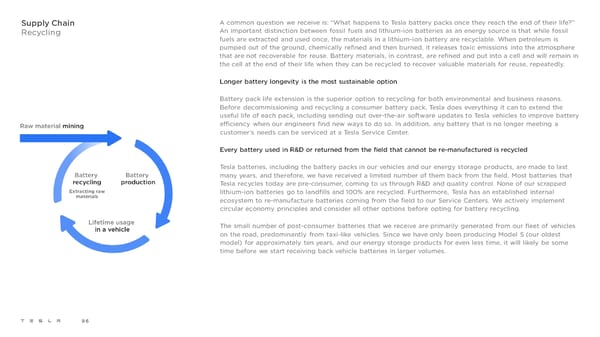Supply Chain A common question we receive is: “What happens to Tesla battery packs once they reach the end of their life?” Recycling An important distinction between fossil fuels and lithium-ion batteries as an energy source is that while fossil fuels are extracted and used once, the materials in a lithium-ion battery are recyclable. When petroleum is pumped out of the ground, chemically refined and then burned, it releases toxic emissions into the atmosphere that are not recoverable for reuse. Battery materials, in contrast, are refined and put into a cell and will remain in the cell at the end of their life when they can be recycled to recover valuable materials for reuse, repeatedly. Longer battery longevity is the most sustainable option Battery pack life extension is the superior option to recycling for both environmental and business reasons. Before decommissioning and recycling a consumer battery pack, Tesla does everything it can to extend the useful life of each pack, including sending out over-the-air software updates to Tesla vehicles to improve battery efficiency when our engineers find new ways to do so. In addition, any battery that is no longer meeting a customer’s needs can be serviced at a Tesla Service Center. Every battery used in R&D or returned from the field that cannot be re-manufactured is recycled Tesla batteries, including the battery packs in our vehicles and our energy storage products, are made to last many years, and therefore, we have received a limited number of them back from the field. Most batteries that Tesla recycles today are pre-consumer, coming to us through R&D and quality control. None of our scrapped Extracting raw lithium-ion batteries go to landfills and 100% are recycled. Furthermore, Tesla has an established internal materials ecosystem to re-manufacture batteries coming from the field to our Service Centers. We actively implement circular economy principles and consider all other options before opting for battery recycling. The small number of post-consumer batteries that we receive are primarily generated from our fleet of vehicles on the road, predominantly from taxi-like vehicles. Since we have only been producing Model S (our oldest model) for approximately ten years, and our energy storage products for even less time, it will likely be some time before we start receiving back vehicle batteries in larger volumes. 96
 Tesla 2021 Impact Report Page 95 Page 97
Tesla 2021 Impact Report Page 95 Page 97